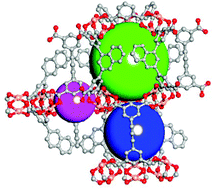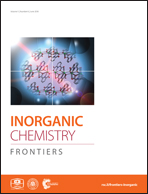Three isoreticular MOFs derived from nitrogen-functionalized diisophthalate ligands: exploring the positional effect of nitrogen functional sites on the structural stabilities and selective C2H2/CH4 and CO2/CH4 adsorption properties†
Abstract
Understanding the structure–property relationship is conducive to the rational design and synthesis of porous MOFs with better performance. In this work, we constructed three isoreticular MOFs derived from quinoline-functionalized bent diisophthalate ligands as a platform to investigate the positional effect of nitrogen functional sites on the structural stabilities and gas adsorption properties of the resulting MOFs. N2 adsorption experiments performed at 77 K revealed that the three MOF compounds exhibited different stabilities against the framework desolvation, which we think is attributed to different accessibility degrees of nitrogen functional sites leading to different interactions between the frameworks and activated solvent molecules. In addition, as a consequence of the incorporation of nitrogen functional sites into the framework, the most stable MOF ZJNU-84 outperformed its parent compound ZJNU-71 in terms of C2H2 and CO2 uptake capacities and C2H2/CH4 and CO2/CH4 adsorption selectivities, indicating its promising potential for the selective separation of C2H2 and CO2 from CH4. However, the enhancement is not as remarkable as expected due to a low degree of accessibility of nitrogen functional sites in the framework.



 Please wait while we load your content...
Please wait while we load your content...